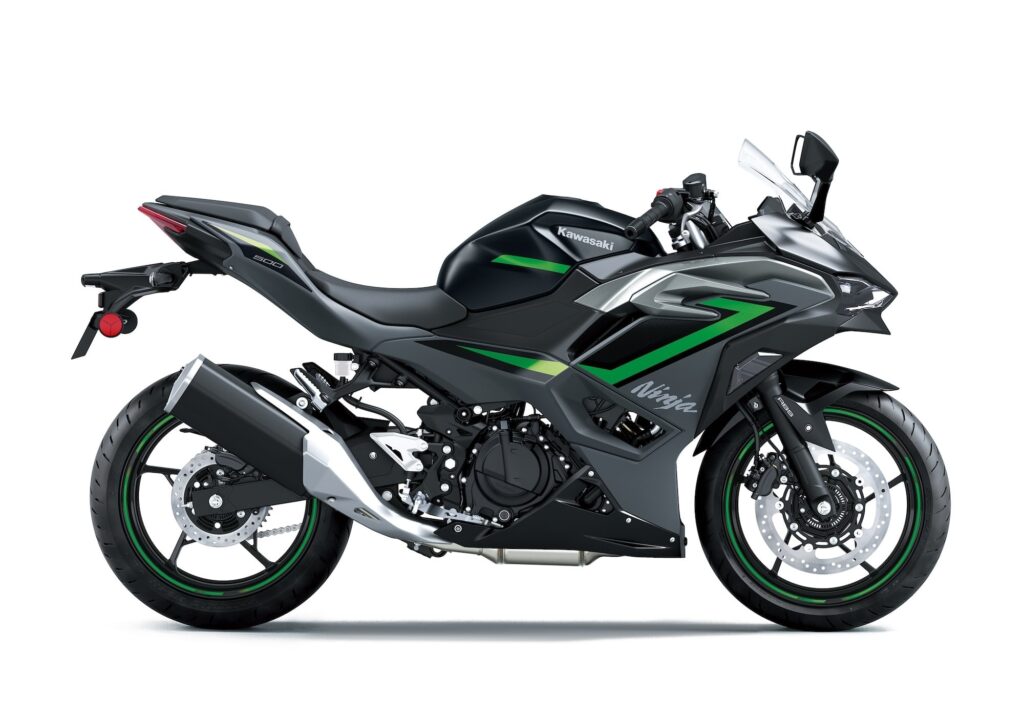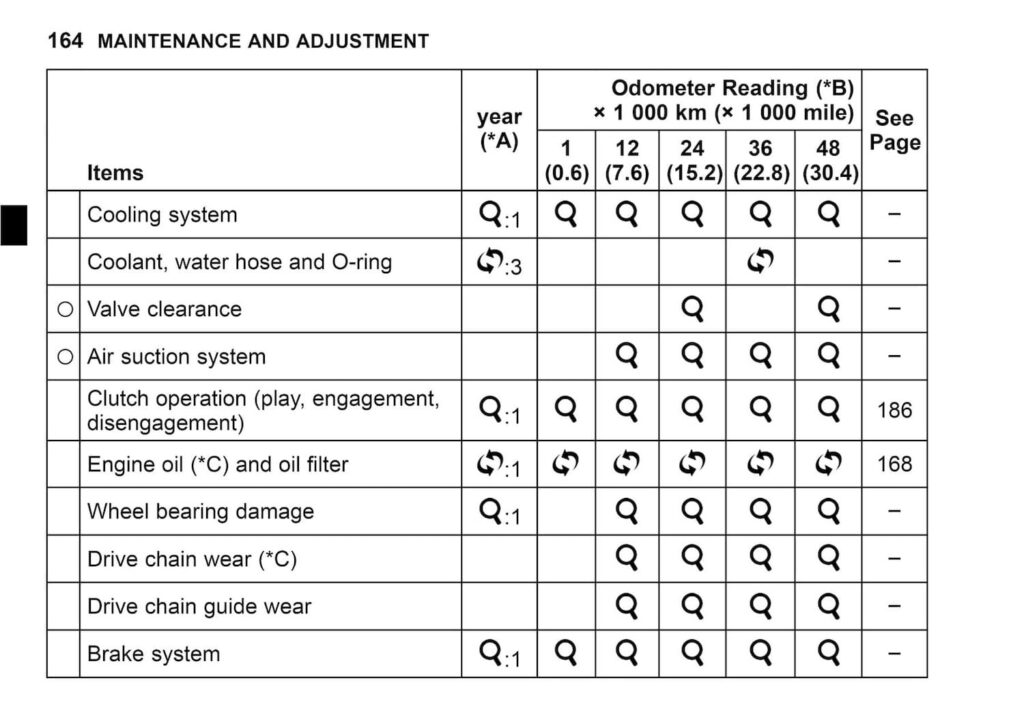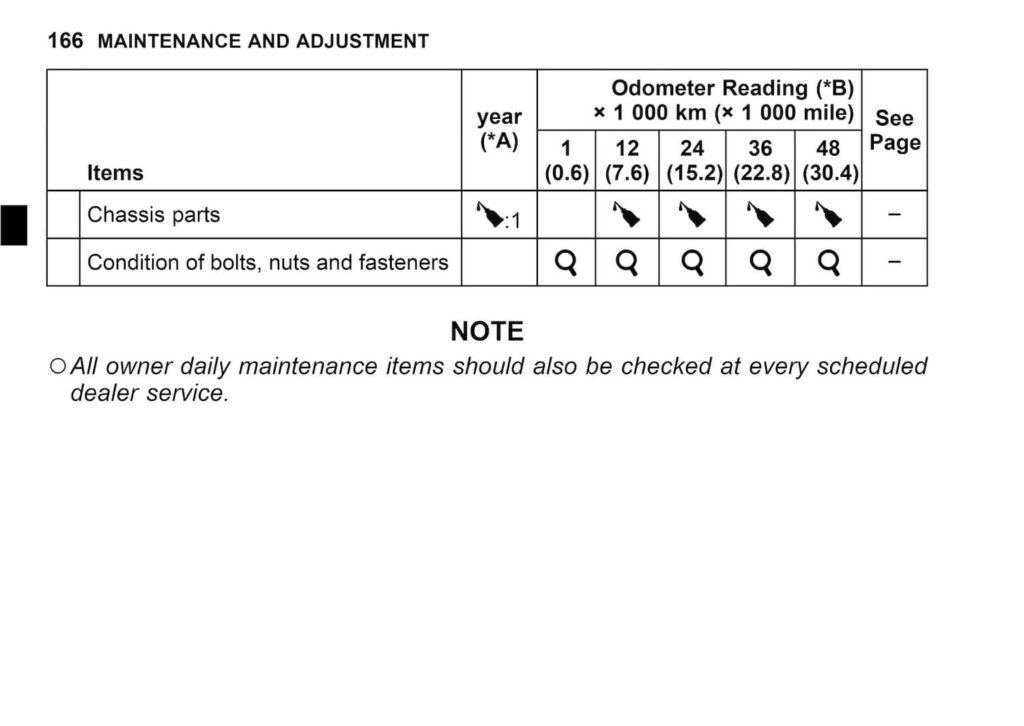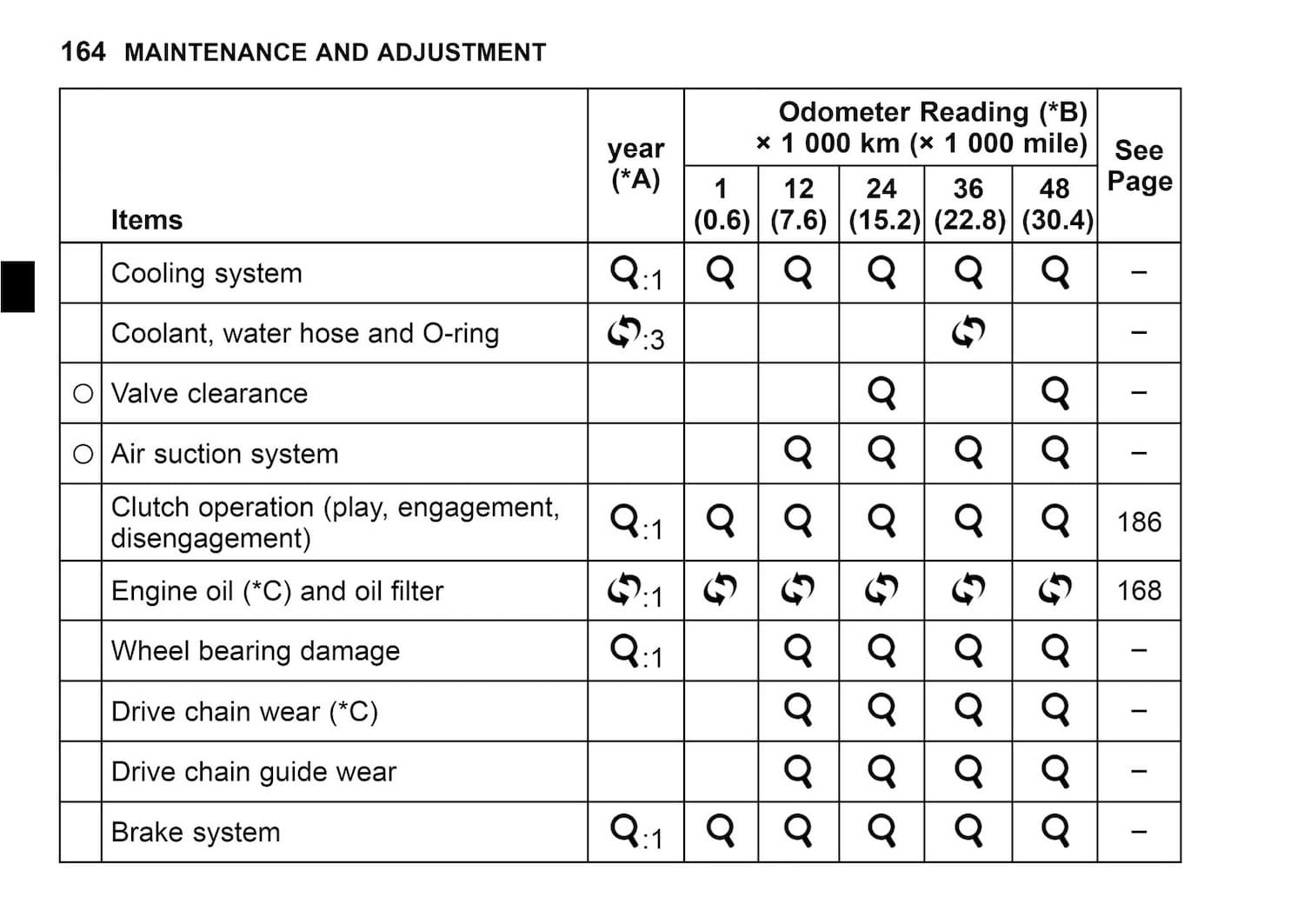Kawasaki Ninja 500 (EX500) Complete Maintenance Schedule
This is the full maintenance schedule for the Kawasaki Ninja 500 (EX500), released in 2024 as a successor to the very popular Ninja 400. — when to change your air filter, spark plugs, and more.
The Ninja 400 was a hit for being both nicely powered and very lightweight. With a few tweaks, it was a favourite for a reliable, economical, and fun track day scratcher for experienced riders.
The Ninja 500 ups the ante with a higher-displacement motor. It makes the same peak power, but has more mid-range torque. And, of course, the newer bike complies with the latest emissions guidelines (the real reason for many of these kinds of updates).
The Ninja 500’s 451 cc (barely rounds up!) parallel twin makes peak power of 33.4 kW (45 hp) at 9000 rpm, and peak torque of 42.6 Nm (31.4 lb-ft) at 6000 rpm. Final drive is via a 6-speed box and chain drive, as before.
Kawasaki previously (decades prior) sold another similar (but quite different) Ninja 500, also an EX500 (the Ninja 500R / EX500R), the predecessor to the Ninja 650. You can find its maintenance schedule here.
Kawasaki contemporaneously released an update to the Z400, the Kawasaki Z500.
This site has links for things like oil and spark plugs from which we earn a commission (which unfortunately nobody can save, not even us). If you appreciate this work, then please use those links. Thanks!
Kawasaki Ninja 500 Service Intervals
The basic service interval for the Kawasaki Ninja 500 is, like that of its predecessor, either every 7600 miles (12000 km) OR every year. At any of those periods, change the oil and filter, and check the schedule to see what you need to adjust inspect, lubricate, or replace.
The valve clearance inspection interval for the Ninja 500 remains a generous 24000 km (15000 miles). The 451 cc parallel-twin engine is easy to service, too, as there’s just one cylinder head, and there’s no need to drop the oil to do a valve service.
The Ninja 500 has a liquid-cooled engine, so make sure you keep the coolant fresh, along with the brake fluid.
Finally, pay attention to the chain. As a bike likely to be a daily commuter, it’s bound to be subject to a lot of stress.
What you need to service your Kawasaki Ninja 500
Like other entry-level Kawasaki Ninja bikes, the Ninja 500 is easy to service. You just need a bunch of basic motorcycle maintenance tools, some floor space, and of course the following consumables.
| Part | Kawasaki Ninja 500 & Z500 Spec |
|---|---|
| Oil | Use 2.3L (2.4 US qt) of SAE 10W-40 engine oil “with API SG, SH, SJ, SL or SM with JASO MA, MA1 or MA2 rating”, preferably Kawasaki 10W-40 Engine Oil, or another high-grade synthetic like Motul 7100 10W-40. Don’t over-torque the drain bolt (spec is 30 Nm/22 lb-ft per the manual) — use a torque wrench if you don’t have experience with how much torque is enough. |
| Oil filter | You can use a Hiflofiltro HF303RC oil filter which fits most Kawasaki engines. Torque for oil filter is 17.5 Nm (12.9 lb-ft) (use a torque wrench if unsure, and it’s easier on the aftermarket one) |
| Spark plugs | NGK LMAR9G, with a spark plug gap of 0.7-0.8mm (0.028-0.031 in). On most models these should be torqued to 13 Nm or 9 ft-lb, but this needs to be confirmed. |
| Cable lubricant | Remember to lubricate your clutch cable (and brake cables if you have them) with a cable lubricant. Protect All Cable Life is a good general-purpose lubricant. |
| Chain lubricant | The chain needs to be lubricated every 600 km/400 miles (or more, if it gets wet/dirty). Motul chain paste is cheap and well-loved. |
| Brake fluid | Spec is to use DOT-4 brake fluid, e.g. Castrol DOT 4. |
| Coolant | Use nitrate-free, phosphate-free, ethylene glycol-based coolant with anti-corrosion inhibitors, e.g. Valvoline Zerex G05 |
| Grease | Use a lithium soap-based grease for all the important greasing points. |
Maintenance schedule for the Kawasaki Ninja 500
Below is the full maintenance schedule for the 2024 Kawasaki Ninja 500.
Notes:
- In the original manual for the 2024 Kawasaki Ninja 500, some items are demarcated as “emissions related” or to be inspected by a dealer. However, the bike is easy to service, so all this is left up to you.
- For clarity, we’ve also separated out the “annual inspection” items from the regular items that need replacement less often (other than engine oil).
| km x 1000 | 1 | 12 | 24 | 36 | 48 | |
|---|---|---|---|---|---|---|
| mi x 1000 | 0.6 | 7.6 | 15.2 | 22.8 | 30.4 | Every |
| Perform annual inspection (see below) | ✓ | ✓ | ✓ | ✓ | ✓ | Year |
| Engine oil — Replace (Kawasaki 10W-40 Engine oil) | ✓ | ✓ | ✓ | ✓ | ✓ | Year |
| Oil filter — Replace (HF303RC) | ✓ | ✓ | ✓ | ✓ | ✓ | Year |
| Spark plugs (NGK LMAR9G) — Replace | ✓ | ✓ | ✓ | ✓ | ||
| Air cleaner element — Replace | ✓ | ✓ | More often if riding in dust / off-road | |||
| Valve clearances — Inspect | ✓ | ✓ | ||||
| Idle speed — Inspect Target 1300 rpm, +/- 50 rpm | ✓ | ✓ | ✓ | ✓ | ✓ | |
| Engine vacuum synchronization — Check | ✓ | ✓ | ✓ | ✓ | ||
| Fuel filter — Replace | ✓ | ✓ | ||||
| Fuel hoses — Replace | 5 years | |||||
| Evaporative emission control system (if fitted) | ✓ | ✓ | ||||
| Coolant, water hoses, and O-rings — Replace all | ✓ | 3 years | ||||
| Air suction system — Inspect | ✓ | ✓ | ✓ | ✓ | ||
| Drive chain wear — Inspect | ✓ | ✓ | ✓ | ✓ | ||
| Drive chain guide wear — Inspect | ✓ | ✓ | ✓ | ✓ | ||
| Brake fluid (front and rear) — Replace (Castrol DOT 4) | ✓ | ✓ | 2 years | |||
| Brake hoses — Replace | 4 years | |||||
| Rubber parts of brake master cylinder and caliper – Replace | ✓ | 4 years | ||||
| Rear suspension system — Lubricate | ✓ | ✓ | ||||
| Steering stem bearing — Lubricate | ✓ | ✓ | 2 years |
Annual inspection
Below is the list of maintenance items for the 2024 Kawasaki Ninja 500 — things to check / lubricate every service (per the schedule above).
| Kawasaki Ninja 500 Annual Inspection |
|---|
| Throttle control system — Inspect (play, smooth return, and no drag) |
| Brake system — Inspect function / leaks |
| Brake operation (effectiveness, play, no drag) |
| Brake fluid level — Check / top up (Castrol DOT 4) (Brake fluid level drops with pad wear) |
| Brake pad wear (not as critical at break-in) Service limit: 1.0mm at front, 1.5mm at rear Inspect more often if riding in dusty / wet conditions, or aggressively |
| Brake light switch operation — Check |
| Fuel system — Inspect (no leaks, kinks, damaged hoses) |
| Cooling system — Inspect (no leaks, kinks) |
| Coolant level — Inspect, top up as necessary (Zerex G05) |
| Clutch operation — Inspect (play, engagement, disengagement) Free play: 2-3 mm |
| Wheels and tires — Check condition (no dents, damage) |
| Wheel bearings — Check for damage / looseness |
| Tire air pressure — Check / adjust (See specs below) |
| Suspension system — Check for leaks, smooth operation Not required at break-in service |
| Steering play — Check for smooth operation, no notchiness |
| Electrical system — Check all lights, signals, and switches work |
| Chassis parts — Lubricate as necessary |
| Bolts, nuts, and fasteners — Check condition, tighten as necessary, or replace |
Maintaining Your Chain on the Kawasaki Ninja 500
The Ninja 500 is an everyday bike, so the chain gets a lot of abuse and is sometimes neglected. It’s important to maintain your chain on the Ninja 400, as on any chain-driven motorcycle.
Use a good-quality chain lubricant like Motul chain paste, or a Motul chain care kit which comes with a couple of handy tools to maintain the chain.
Kawasaki recommends you follow the following chain maintenance schedule:
| Chain maintenance item | Every |
|---|---|
| Check drive chain lubrication condition, lubricating if necessary (Motul chain paste) | 400 mi / 600 km |
| Check drive chain slack, adjusting if necessary (See below) | 600 mi / 1000 km |
Notes:
- Do these items (checking/adjusting slack, and checking/applying lubrication) more often if you ride your Ninja 400 in dusty or rainy conditions.
- Always lubricate the chain after washing the motorcycle.
To check the slack on the Kawasaki Ninja 500, put it in neutral, onto its kickstand, and on a level surface.
Check the slack on the lower part of the chain, midway between the sprockets, and check it in multiple places (move the motorcycle forwards and backwards) as chains wear unevenly.

Slack on the Ninja 500 is defined as the free vertical movement of the lower part of the chain.
Target chain slack for the 2024 Ninja 500: 20 – 30 mm (0.8 – 1.2 in)
If the chain slack is out of spec, you need to adjust it.
Adjusting Chain Slack
To adjust the chain slack on the Ninja 500, follow the steps below. As with measuring chain slack, make sure that the motorcycle is on a level surface on its kickstand, in neutral, with no weight on it (don’t leave your tools there).
- Remove the axle cotter pin (refer to the image above to see what’s where). Loosen the rear axle and the adjuster lock nuts on both sides of the axle.
- Turn the chain tension adjuster nuts to tighten (or loosen) the chain. Keep checking the chain tension to see if it has come within spec.
- Keep an eye on the adjuster alignment marks on either side of the axle. Make sure that the adjustment is to the same point.
- When you’re done, tighten the axle to 98 Nm / 72 lb-ft. You’ll need a large torque wrench.
- Re-check the chain slack again to make sure it’s still within spec.
Tire sizes and pressures for the Ninja 500
The manual specifies the following tire sizes, pressures, and brands (that it ships with, though people rarely stick with them).
Stock, the Ninja 500 ships with Dunlop Sportmax GPR tires, but it will take any street / sport tires.
| Tyre | Size | Tire pressure (cold) |
|---|---|---|
| Front | 110/70R17 M/C 54H | 200 kPa (2.0 bar) / 28 psi |
| Rear | 150/60R17 M/C 66H | 225 kPa (2.25 bar) / 32 psi |
About the Kawasaki Ninja 500 (2024 model)

Kawasaki (re)-released the Ninja 500 for the 2024 model year as an update to the already very popular Ninja 400, which it had sold since 2018.
The Ninja 500 is actually the second bike of the same name that has been produced. The previous one was made decades prior. Needless to say, the modern Ninja 500 is quite different!
The old Ninja 500 was a similar concept of bike — an everyday street / sport bike — but was powered by a carburettor-fed 498 cc parallel twin that made decent power of 44 kW / 60 hp at 9800 rpm. It wasn’t intended to be a learner bike under what we now know as the European A2 license scheme (or the Australia / NZ LAMS scheme). The old Ninja 500 is a great little bike and there are tons of them still on the road — classically unkillable Kawasaki Ninjas.
So the modern 2024 Ninja 500 is an update to the Ninja 400, a rebirth (of sorts) of the old 500, and also a little sibling to the modern Ninja 650. But it deserves its own place among the fray.
Here’s how it compares to its modern siblings:
| Item | 2018-2023 Ninja 400 | 2023+ Ninja 650 | 2024+ Ninja 500 |
|---|---|---|---|
| Engine | 399 cc parallel twin | 649 cc parallel twin | 451 cc parallel twin |
| Compression ratio | 11.5:1 | 10.8:1 | 11.3:1 |
| Peak power | 35 kW / 48 PS @ 10000 rpm | 50.2 kW / 68 PS @ 8000 rpm | 33.4 kW / 45 PS at 9000 rpm |
| Peak torque | 37 Nm / 28.0 lb-ft @ 8000 rpm | 48.5 lb-ft @ 6500 rpm | 42.6 Nm / 31.4 lb-ft @ 6000 rpm |
| Front suspension | 41mm conventional fork | 41mm conventional fork | 41mm conventional fork |
| Rear suspension | Bottom-link Uni Trak suspension, 5-way preload adjustable | Horizontal back-link with adjsutable preload | Bottom-link Uni Trak suspension, 5-way preload adjustable |
| Front brakes | Single 310 mm disc, dual-piston caliper | Dual 300 mm discs with 2-piston calipers | Single 310 mm disc, dual-piston caliper |
| Curb weight | 166 kg | 192 kg | 171 kg |
| Display | Analogue | TFT | TFT |
| Ride aids | ABS | ABS, TC (2-mode + off) | ABS |
The Ninja 500 is, essentially, a Ninja 400 but with a slightly lower-revving motor. It makes more torque and it makes it earlier, prioritising mid-range performance over top-end pull. This brings it quite close to the way the Kawasaki Ninja 650 performs (when in non-restricted spec).
The rest of the Ninja 500 should be familiar territory for anyone who rids a Ninja 400. It’s a lightweight, easy to use, dependable and versatile bike, with graphics and styling that mimics that of its bigger siblings — including the high-end supersports.
The ride gear remains basic, with a conventional (non-inverted) fork up front and a single disc brake. This means fewer points of failure, of course, and also easier maintenance in general.
General ride reports of the Ninja 500 are much like those of the Ninja 400 — though this is, being a lower-revving, higher-torque motorcycle — even easier to ride. Revzilla’s Common Tread’s reviewers rated the Ninja 500 more highly than the Z500, as the Ninja has basically as relaxed a riding position and is even more comfortable with its windscreen and fairing.
The only downside in the eyes of people who like classic things is the technology upgrade of the Ninja 500. Some of us like analogue dials! But I acknowledge that we’re a dying breed.
The build of the Ninja 500 is convenient for people who like to do their own service. The fairing is open at the rear, which means you get easy access to the oil filler cap. The dual swing arm means chain tension adjustment is easy (no special tools). But bodywork still has to come off when it’s time to do a valve clearance adjustment.
But the best news is the 40th Anniversary Edition, which comes in some great colours. Instant classic! (Unfotunately, it’s not available in most markets — it appears to be exclusive to the US.)
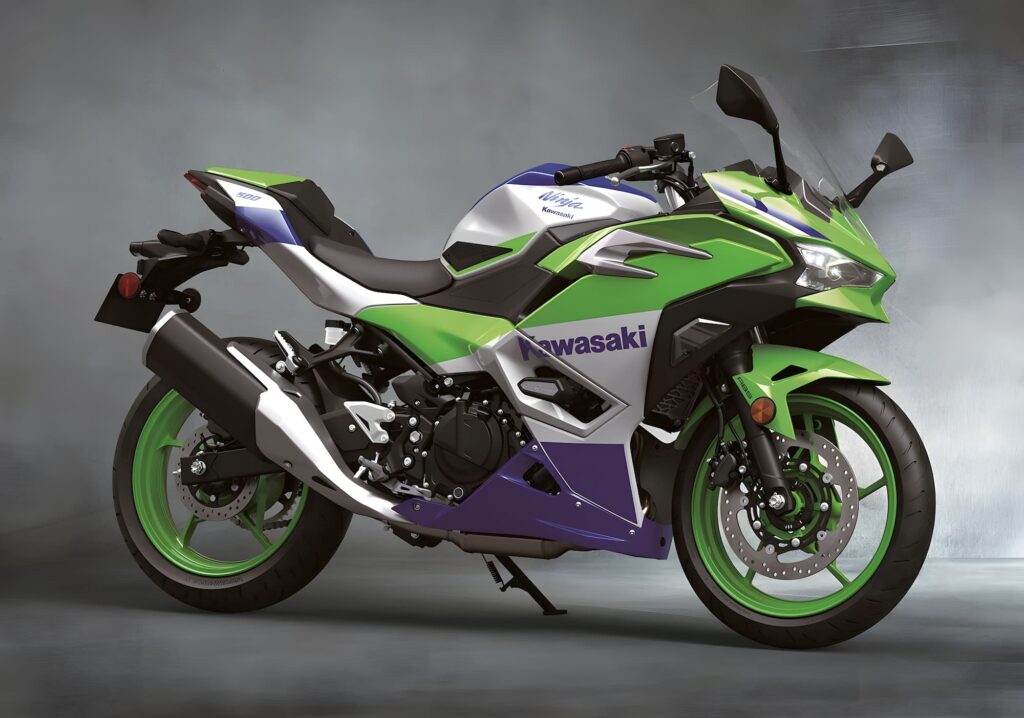
Manual for the Kawasaki Ninja 500
The above maintenance schedule was transcribed from the manual for the Ninja 500, with reference to parts diagrams.
You can view the manual online at Kawasaki’s website here.
Below is an extract of the maintenance-relevant sections of the 2024 Kawasaki Ninja 500’s manual.

